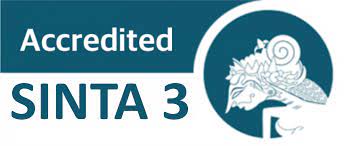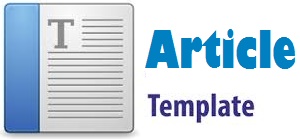فعالية طريقة التقليد والتحفيظ في ترقية مهارة الكلام
Abstract
في الواقع، ما زال تعليم مهارة تحت سيطرة المعلم ولا يتيح الفرصة لدى الطلاب ليشتركوا بجهد ونشاط في الأنشطة التعليمية والتدريبات حتى أن الدارسين لم يستطيعوا أن يتكلموا باللغة العربية ويشعرون بالممل في تعلم اللغة العربية. كما وجد الباحث في المدراسة الثناوية الإسلامية الحكومية غينوك واتو بجومبانج. فيجرّب الباحث استخدام طريقة التقليد والتحفيظ. أما منهج هذا البحث فهو المنهج التجريبي بالمدخل الكمي. وأسلوب جمع البيانات هو الملاحظة والمقابلة والاختبار والوثائق. وأسلوب تحليل البيانات هو بطريقة الاحصاء الاستدلالي. أما نتيجة هذا البحث فهي: استخدام طريقة التقليد والتحفيظ خمس الخطوات. ونتيجة الإحصائي = 16,78 أكبر من نتيجة التقدير المعنوي 1% = 2,056 وكذلك أكبر من نتيجة تقدير المعنوي 5% = 2,771 بمعنى أن "Ha" مقبول أو أن فرضية هذا البحث مقبولة. وهذا دليل أن استخدام طريقة التقليد والتحفيظ فعال في ترقية كفاءة الطالب في مهارة الكلام.
In fact, the teaching skills of speaking so far that is still under the control of teachers and few opportunities for students to participate in efforts and activities in education and training so that students have not been able to speak Arabic and was bored in learning Arabic, such as the problems that the researchers find in Islamic High School of Genukwatu Jombang. Therefore, researchers tried using the mimicry and memorization method. The study design used experiment research with quantitative approach. Data collection techniques with inferential statistics. Results from these studies: the use mimicry and memorization method with five steps. Statistical results = 16.78 is greater than the result t.s 0.01 = 2.056 and t.s 0.05 = 2.771, which means Ha and the research hypothesis is accepted. And this is evidence that the use mimicry and memorization method effective method to enhance students' skills in speaking skills.
Keywords
Full Text:
PDFReferences
Haq, Moh.Fakhri Zainul. 2011. “Efektifitas Penggunaan Metode Mimicry and Memorization Untuk Meningkatkan Kemahiran Berbicara.” Universitas Pendidikan Indonesia Bandung. Retrieved (repository.upi.edu).
Izzan, Ahmad. 2004. Metodologi Pembelajaran Bahasa Arab. Bandung: Humaniora.
M. Abdullah Charis. 2014. Cara Mudah Berbicara Bahasa Arab. Sidoarjo: Lisan Arabi.
Malibary, A.Akrom. 1976. Pedoman Pengajaran Bahasa Arab Pada Perguruan Tinggi Agama/IAIN. Jakarta: Depag RI.
Me, Fans of. 2012. “Unit-2-Mimicry-Memorization.” Retrieved (http://englishteachingtechniques.blogspot.co.id/2012/09/unit-2-mimicry-memorization.html).
Nuha, Ulin. 2011. Ragam Metodologi Dan Media Pembelajaran Bahasa Arab. Yogyakarta: DIVA Press.
Sugiyono. 2015. Metode Penelitian Pendidikan: Pendekatan Kuantitatif, Kualitatif, Dan R&D. Bandung: Alfabeta.
Suharso and Ana Retnoningsih. 2009. Kamus Besar Bahasa Indonesia. Semarang: Widya Karya.
أحمد فؤاد عليان. 1992. المهارات اللغوية ماهيتها وطرائق تدريسها. الرياض: دار السلم.
اللبودي, منى إبراهيم. 2003. الحوار: فنيّاته واستراتجياته وأساليب تعليمه. القاهرة: مكتبة الذهبية.
مدكور, على أحمد. 2010. طرق تدريس اللغة العربية. عمان: ، دار المسيرة للنشر والتوزيع.
DOI: https://doi.org/10.18860/abj.v2i2.5362
Refbacks
- There are currently no refbacks.
Copyright (c) 2017 Abjadia

This work is licensed under a Creative Commons Attribution-NonCommercial 4.0 International License.
...............................................................................................................................................................
Mailing Address:
Ruang Jurnal Abjadia, Fakultas Ilmu Tarbiyah dan Keguruan (FITK)
Universitas Islam Negeri (UIN) Maulana Malik Ibrahim Malang
Jalan Gajayana 50 Malang 65144, Jawa Timur, Indonesia
Phone/Faximile: (+62341) 552398, Phonsel: +6281333666063
Website: http://ejournal.uin-malang.ac.id/index.php/abjadia
Email: abjadia@uin-malang.com
Abjadia: International Journal of Education. This work is licensed under a Creative Commons Attribution-ShareAlike 4.0 International License.
...............................................................................................................................................................
Indexed by:






